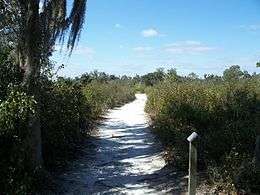Paynes Creek Historic State Park
| Paynes Creek Historic State Park | |
|---|---|
|
IUCN category V (protected landscape/seascape) | |
 | |
 Site of park in U.S. state of Florida | |
| Location | Hardee County, Florida, USA |
| Nearest city | Bowling Green, Florida |
| Coordinates | 27°37′33″N 81°48′14″W / 27.62583°N 81.80389°WCoordinates: 27°37′33″N 81°48′14″W / 27.62583°N 81.80389°W |
| Governing body | |
|
Payne's Creek Massacre--Fort Chokonikla Site | |
| Nearest city | Bowling Green, Florida |
| Area | 400 acres (161.9 ha) |
| Built | 1849 |
| NRHP Reference # | 78000944[1] |
| Added to NRHP | November 21, 1978 |
Paynes Creek Historic State Park is a Florida State Park located on Lake Branch Road one-half mile southeast of Bowling Green, Florida. On November 21, 1978, it was added to the U.S. National Register of Historic Places, under the title of Payne's Creek Massacre-Fort Chokonikla Site (also known as "site of Chokonikla blockhouse and bridge" or "Military cemetery").
History
After the Second Seminole War
When the Second Seminole War ended in 1842, the federal Armed Occupation Act was passed. It let Seminole War veterans apply for a 160-acre (0.6 km2) homestead in Florida.
At the same time, a reservation was created for the Seminoles in southwest Florida. Their ability to trade was limited by the government, so as to prevent them from obtaining weapons to cause further conflict. To compensate, white-run trading stores were permitted on the reservation's outskirts to the north and west, letting the Indians obtain supplies and luxuries unavailable within the reservation.
Many of the trading posts were built by Kennedy and Darling, two army sutlers from Fort Brooke who had started their own trading company. One such was constructed in the late 1840s along the Charlo-popka-hatchee-chee (Little Trout-Eating Creek in Seminole), west of Peas Creek (later known as the Peace River), near present-day Bowling Green. The proprietors were Capt. George Payne and Dempsey Whidden.
The massacre
Ignoring the terms of the treaty with the Seminoles, settlers moved southward, encroaching on the reservation. Though Billy Bowlegs, one of their leaders, was reconciled to the state of affairs, others of his people were not so compliant.
On July 17, 1849, Payne and Whidden were killed by five renegade Seminoles, following which the store and everything in it was burned.
Fort Chokonikla

The attack on the trading post caused many of the settlers to flee to the nearest fort, then ask for military forces to be sent so they could return to their homes in safety. This led to the establishment of Fort Chokonikla near the site of the former trading post only three months later, on October 26. The fort's name is believed to derive from the Seminole "Chocka-nickler" meaning "burnt store". It was also variously spelled at the time as "Chokkonickla" or "Chokhonikla".

Following the fort's completion, the nearby creek became known as Paynes Creek, which it is still called to this day.
However, due to its location near a swamp, a breeding site for mosquitos, many of those stationed at the fort contracted and died of malaria. This became such a problem that the fort's doctor recommended the fort's closure. The army quickly agreed, and the fort was vacated on July 18, 1850, after less than nine months of occupancy, and a year and a day after Payne and Whidden's deaths.
Recreational activities
Activities include canoeing, kayaking, fishing, and bird and butterfly watching. Amenities include a number of historic sites, three picnic pavilions, and a museum at the visitor's center that recreates pioneer life.
Hours
Florida state parks are open between 8 am and sundown every day of the year (including holidays).
References
- ↑ National Park Service (2010-07-09). "National Register Information System". National Register of Historic Places. National Park Service.
External links
![]() Media related to Paynes Creek Historic State Park at Wikimedia Commons
Media related to Paynes Creek Historic State Park at Wikimedia Commons
- Paynes Creek Historic State Park at Florida State Parks
- Paynes Creek State Historic Site at Absolutely Florida
- Hardee County listings at National Register of Historic Places
- Hardee County listings at Florida's Office of Cultural and Historical Programs
- Fort Chokonikla at Ghost Towns and History of the American West
- Fort Chokonikla at Cracker Barrel - Genealogy & History By Spessard Stone
- Allen C. Altvater webpage

